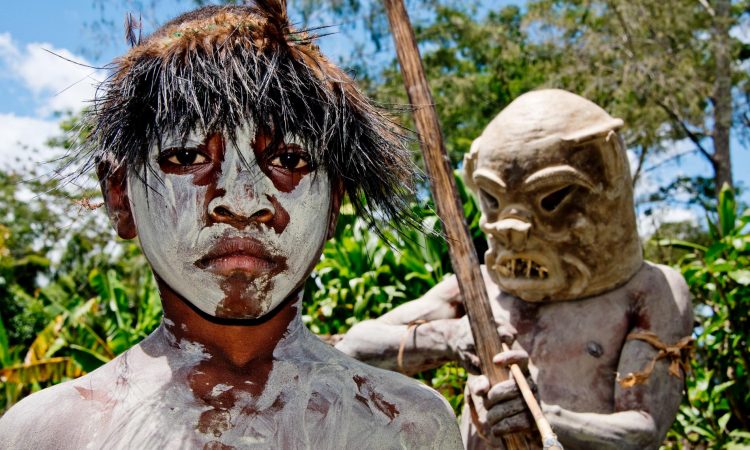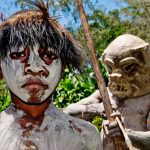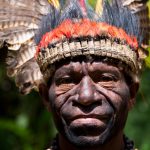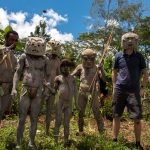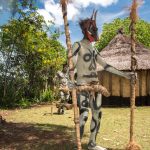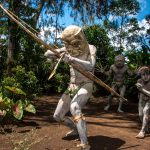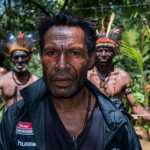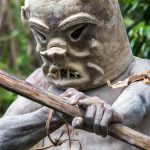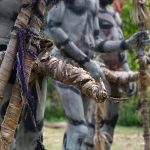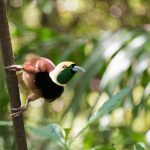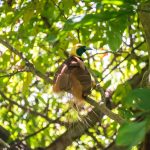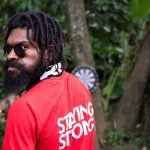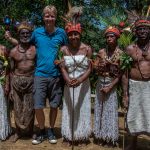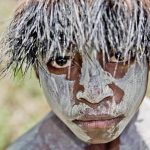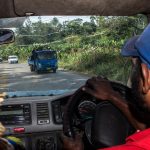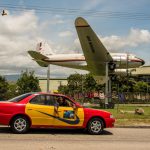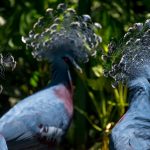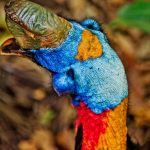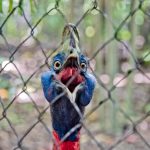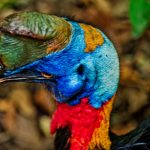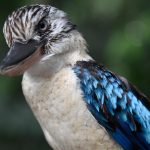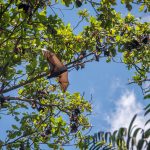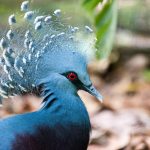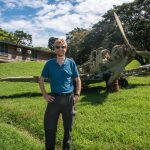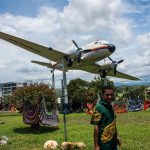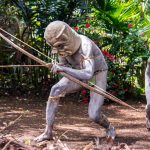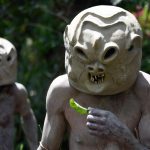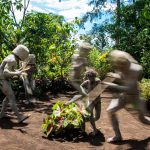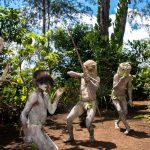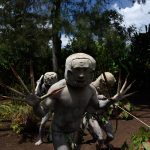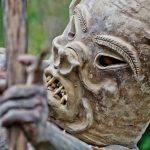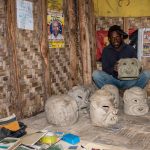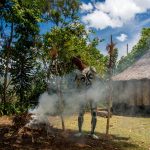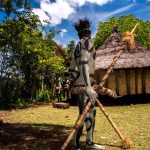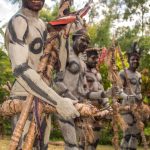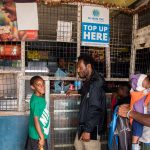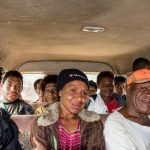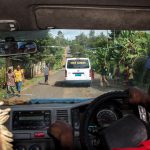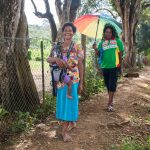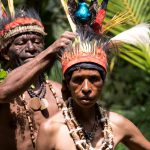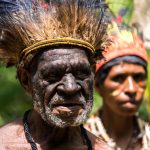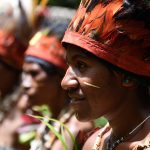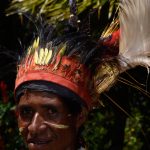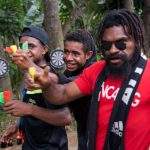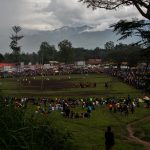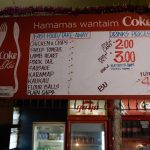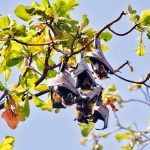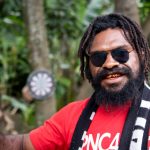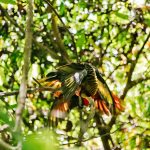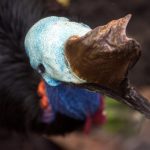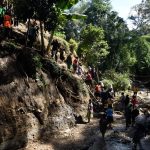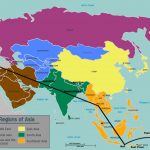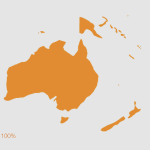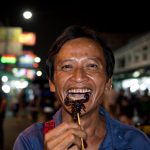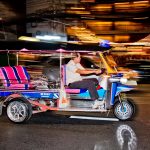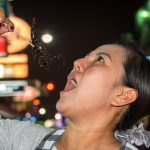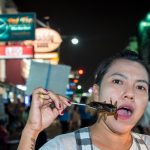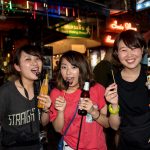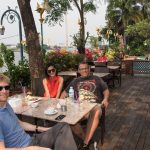Papua New Guinea. Close your eyes and say the name. Maybe that makes you think of Cannibals. Maybe birds of paradise. Maybe you have heard of the mudmen performing their war dance near the Asaro river.
 For many years Papua New Guinea has been one of the top destinations on my travel bucket list. It has been a dream to visit the country sometimes described at ‘the last place on earth to be civilized’
For many years Papua New Guinea has been one of the top destinations on my travel bucket list. It has been a dream to visit the country sometimes described at ‘the last place on earth to be civilized’
The cheapest way to PNG from Denmark is to fly to Bangkok. Continue with Air Asia to Bali (around 100 USD one way) and from there with Air Niugini to Port Moresby, PNG (app USD 600 return)
In Bangkok I celebrate beeing on the road again (and having just successfully although stressfully checked of Libya from my list). I celebrate bý eating a scorpion and a cockroach. These are available from street stalls in the infamous Khao San Road and eating strange insects seem to be the thing to do these days. Each skewered insect sets me back 50 Baht (USD 1,5) and both animals taste like any other deep fried insect – salty and fat like chips. In the background a cover band is covering the same Oasis song they seem to have been covering for the last 20 years.
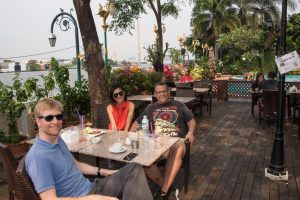 In Bangkok I meet Ric Gazarian. Ric excellently interviewed me a few months back for his Counting Countries podcast. Ric lives in Bangkok and I have lunch with him and his sweet wife Mai at New Siam Riverside Restaurant near the Chao Phraya River. Ric has made his money from investing in properties in the Chicago area and now he spends his time between Bangkok, Chicago and the road since he – like me – is trying to visit every country in the world.
In Bangkok I meet Ric Gazarian. Ric excellently interviewed me a few months back for his Counting Countries podcast. Ric lives in Bangkok and I have lunch with him and his sweet wife Mai at New Siam Riverside Restaurant near the Chao Phraya River. Ric has made his money from investing in properties in the Chicago area and now he spends his time between Bangkok, Chicago and the road since he – like me – is trying to visit every country in the world.
I may soon get the record for most physical meetings with other members of the facebook group Every Passport Stamp. By chance I two days later see a post from Jessica Elliott (How Dare She) in Bali. I know Jessica remotely since we both interviewed Eric Nguyen when he visited his last country and started applying for the Guinness World Record of youngest person to visit every country (at age 24). Back then Jessica interviewed Eric for the Huffington Post. The place I suggest that we meet unfortunately turns out to have either moved or closed (I last visited 14 years ago and thought it would still be there) so google maps show both of us a ramschackle house in an abandoned area – but we finally manage to meet at a nearby beach café. Jessica is super cool and one of the very few female travelers trying to visit every country. My chance meeting with Jessica provides me with a name of a highly recommended guide in the highlands of Papua New Guinea. Chance meetings and networking can get you a long way in travel.
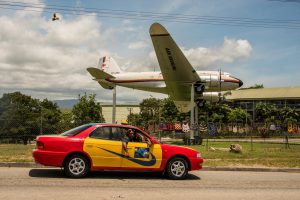 “Here in Port Moresby it is too dangerous for a white man to be walking the streets on his own” I am told at the reception at the Gateway Hotel when I am checking in at 5am after my night flight from Bali. I am pretty tired but try to argue that I have just been to Libya so I think I will be alright here. But the receptionist insists: “Many white people are held up by knife” she says.
“Here in Port Moresby it is too dangerous for a white man to be walking the streets on his own” I am told at the reception at the Gateway Hotel when I am checking in at 5am after my night flight from Bali. I am pretty tired but try to argue that I have just been to Libya so I think I will be alright here. But the receptionist insists: “Many white people are held up by knife” she says.
So, I agree for Eddy to escort me around for 40 PNG Kina (about 10 USD). We go on normal roads and see normal innocent looking people and nice new cars – and I have absolutely no idea why I need a guide for security – but Eddy is a nice guy and I can use him as a model in a few photos 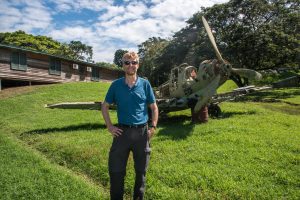 that I think need a person in the foreground. We see the Parliament, the National Muesum and a Bird Park with some of the strangest looking and incredible birds I have ever seen. Including of course the national bird of Papua New Guinea: the bird of paradise. (I later found out that a bus full of Asians were recently robbed just outside the parliament gate so it might have been 40 Kina well spent after all).
that I think need a person in the foreground. We see the Parliament, the National Muesum and a Bird Park with some of the strangest looking and incredible birds I have ever seen. Including of course the national bird of Papua New Guinea: the bird of paradise. (I later found out that a bus full of Asians were recently robbed just outside the parliament gate so it might have been 40 Kina well spent after all).
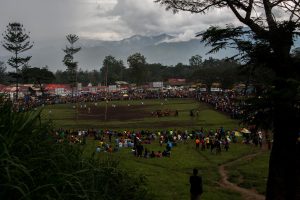 From Port Moresby I board a small Dash-8 Q300 propeller plane taking me the East Highland province town of Goroka. Beautifully situated and encircled by the majestic highland mountains. Everyone in PNG has been telling me how cold and wet Goroka is, but when I step of the plane (and for the next three days) it is warm and sunny with temperatures around 25 degrees Celsius. I stay at the lovely Lutheran Mission Guesthouse at a daily rate of around 35 USD (Hotels start from USD 120 in comparison).
From Port Moresby I board a small Dash-8 Q300 propeller plane taking me the East Highland province town of Goroka. Beautifully situated and encircled by the majestic highland mountains. Everyone in PNG has been telling me how cold and wet Goroka is, but when I step of the plane (and for the next three days) it is warm and sunny with temperatures around 25 degrees Celsius. I stay at the lovely Lutheran Mission Guesthouse at a daily rate of around 35 USD (Hotels start from USD 120 in comparison).
Caspar – the guide that I have had recommended is a nice guy, 45 years of age and with three  children – the youngest being Mona Lisa aged 8 (who later comes with us for one of our tribal excursions) – and two grandchildren. I ask him if he knows about Mona Lisa and Van Gogh and how he cut of his own ear. Caspar has never heard of this but he listens with great interest when I tell him the story.
children – the youngest being Mona Lisa aged 8 (who later comes with us for one of our tribal excursions) – and two grandchildren. I ask him if he knows about Mona Lisa and Van Gogh and how he cut of his own ear. Caspar has never heard of this but he listens with great interest when I tell him the story.
The next morning when we are supposed to go visit the Asaro Mudmen Caspar is nowhere to be seen. “Oh Caspar..” Alfons who works at my guesthouse says. He pauses for a bit as if unsure if he should go on “I saw him down near the market yesterday. Drinking”. Oh boy. Will I need to find another guide now?…
About an hour later Caspar fortunately shows up. “You alright Boss-Man” I say to him because this is what all the locals seem to be saying all the time here. “Me alright tasol” Caspar replies (I am fine) even though with his teeth red from chewing betel nut and his bloodshed eyes he looks like a vampire who has been drinking vodka mixed with blood the whole night.
“How many beers did you have last night?” I ask him. I got a compliment him for his honesty here. ”Nine” he tells me. Hehe. NINE beers. I still have alcohol in my blood he truthfully says. Apart from this I must emphasize that Caspar is the best guy and the best guide one can think of and the trips that we did together went exactly as planned and turned out to be even better than I had hoped for.
It is rainy season and a few weeks back the solid bridge on the Highland Highway just outside Goroka (to the west) was washed away in heavy flooding. Since we are heading that way to get to the Asaro region Caspar has hired a taxi to take us for a long detour on potholed gravel roads. After we pass an old bridge spanning the river we are led back to the Highland Highway. Now and again young road workers blocks the road with homemade speed bumps made of piled up earth. They want us to pay for filling out the potholes (for which the government supposedly does not pay them) so they ask for a few coins or cigarettes to pass.
Now some may have a romantic idea that the tribal people of PNG will talk only an incomprehensible language, that they are living completely isolated lives and that the only white person they have ever met is one that they have eaten. In 2018 this is however not the situation among most of the worlds remaining tribal people. Not many white and unexplored spots are left on the map. “We haven’t had cannibals in Papua New Guinea in 50 years” Caspar just dryly states.
Pondo, Ali Junior, Guri, Ali Senior and a few other men from the Asaro tribe meet us where the dirt road leads up from the Highland Higway towards the Asaro village. Together we climb the road that shortly turns into a more rugged and winding path. Pondo and Guri are both mud-men and are going to take part in the War Dance that I am soon about to witness. Like every other Asaro man they speak the Takano language but they also speak Tok Pissin (Pidgin) the national language of PNG and Pondo also speaks English and “8 other local languages” he says. On my travels I have had the pleasure of meeting numerous tribal people around the globe. Very rarely have I been able to communicate directly with them without an interpreter. Here I can actually talk to Pondo without my questions being lost in translation and connecting is made much easier.
Ali Senior is my local Asaro guide. In despite of their names he is not the father of Ali Junior. He is just an older Ali. Both Ali’s are Christians even though they have predominately Muslim names. Everyone in PNG is Christian Caspar informs me “unless they live deep in the jungle and have animistic beliefs”. Ali Senior is well informed. He knows that the capital of Denmark is Copenhagen and he knows most of the capitals around the world. He is good at explaining things and he tells me the legend of the Asaro Mud-men:
In old times a group of locals inhabited an area near the Asaro river and hence took name after the 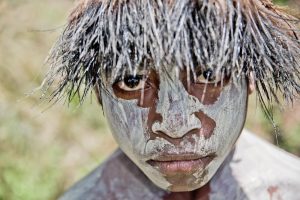 river. They settled there because of the great fertility of the area. But enemies came and tried to steal their land. The Asaro people fled but were driven to a swampy area. To try to escape they went in to the muddy swamp. The swamp was too deep to cross so they came back up all covered in mud. As a last resort they decided to move forward slowly and shifting from side to side looking as creepy as they could. Fortunately, the enemy thought that the Asaro people were dead spirits haunting the place and ran away. Since then the Asaro Mud-men have performed their ritual dance at the annual Goroka show and at other ceremonies. “We are always in top 3 when they give out prices” Pondo says “-usually we are first”.
river. They settled there because of the great fertility of the area. But enemies came and tried to steal their land. The Asaro people fled but were driven to a swampy area. To try to escape they went in to the muddy swamp. The swamp was too deep to cross so they came back up all covered in mud. As a last resort they decided to move forward slowly and shifting from side to side looking as creepy as they could. Fortunately, the enemy thought that the Asaro people were dead spirits haunting the place and ran away. Since then the Asaro Mud-men have performed their ritual dance at the annual Goroka show and at other ceremonies. “We are always in top 3 when they give out prices” Pondo says “-usually we are first”.
I understand why when I see their dance. Enshrouded in the smoke from a fire they slowly come out of the jungle moving slowly from side to side and looking vicious. On their bodies they have smeared themselves with clay from a special village. Their penises are held by a cup made of dried banana leaves. Their masks are made from the same clay. It is molded and left to dry inside their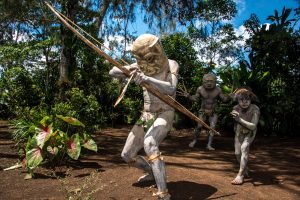 houses (if it dries outside in the sun the masks will crack). The teeth – tusks and normal teeth – are from their pigs. The name of the chief is Serviro – he carries a bow made of wood from the palm tree with a hard string made of bamboo, Ali Junior has applied long thin creepy looking fingers also made of bamboo, Guri has a spear, Pondo just holds a leaf (used to get rid of the flies). All the adult men have vicious masks. The young boy Yurax wears a wig made of bird feathers.
houses (if it dries outside in the sun the masks will crack). The teeth – tusks and normal teeth – are from their pigs. The name of the chief is Serviro – he carries a bow made of wood from the palm tree with a hard string made of bamboo, Ali Junior has applied long thin creepy looking fingers also made of bamboo, Guri has a spear, Pondo just holds a leaf (used to get rid of the flies). All the adult men have vicious masks. The young boy Yurax wears a wig made of bird feathers.
After the dance we go through the ‘kau kau’ fields. This is where the Asaros grow their sweet potatoes – their main staple – they eat this three times a day. We the go to see Pondos house. He has built it himself. There is a fireplace inside the house and the roof is made of “kunai” grass that “allows the smoke out but does not allow the rain in”. Inside in the hut hang posters for some local political candidates. On the ground lies Pondos writing utensils. In the corner sits nine mud-men masks. “We can make shows with more that one hundred mud-men” Pondo tells me, “only one of course has to be an Asaro to perform at the ceremonies”
In the afternoon we walk for about an hour through the highland to get to another village where another Asaro tribe resides (The Asaro people consists of ten different tribes). On the way I buy lunch from a couple of old ladies sitting by the side of the road. Ali Junior & Senior and Pondo and Guri and Caspar and a few hangarounds have come with me. I buy a deep fried roll (and have no idea how they have deep fried it out here) and 1-2 bananas for each of us 8 adults and the total bill comes to PNG Kina 6,80 or about USD 2. Cheap lunch. The Kina 3.20 change I let my friends spend on betel nuts.
The story behind the skeleton dance that we see in the next village is that after winning and 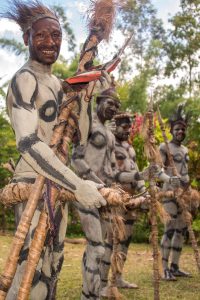 important fight this Asaro tribe came back to their village and decided to dress up as skeletons to celebrate their victory. The victory rhetoric is certainly visible when I see the young men wearing huge penises made out of dried banana leaves. They are about the size of French baguettes. Finally, after years of traveling I get to meet tribal people who have comparable wieners to Oysterboys own!
important fight this Asaro tribe came back to their village and decided to dress up as skeletons to celebrate their victory. The victory rhetoric is certainly visible when I see the young men wearing huge penises made out of dried banana leaves. They are about the size of French baguettes. Finally, after years of traveling I get to meet tribal people who have comparable wieners to Oysterboys own!
The next day we go to see a ’Sing Sing’ performed by the Luhaka tribe in a village named Hagareto. The Luhaka tribe performs at the two annual national Sing Sings – the Goroka Show and The Mt Hagen Show – but also it is possible to arrange smaller private shows. Today we go with the local bus called a PMV (Public Motor Vehicle). A PMV seems to have no upper limit to how many people can fit in the cabin – but it is a cheap and cheerful way to get 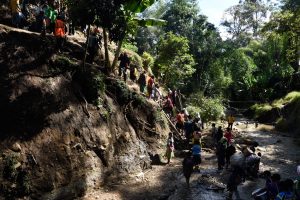 around and talk to the welcoming locals. Our first PMVs takes only a short distance to the collapsed bridge just outside of Goroka. Here we have to descent and climb the steep riverbanks and cross the river at the bottom on foot. Fortunately, it has not rained for the last two days so the water is very low.
around and talk to the welcoming locals. Our first PMVs takes only a short distance to the collapsed bridge just outside of Goroka. Here we have to descent and climb the steep riverbanks and cross the river at the bottom on foot. Fortunately, it has not rained for the last two days so the water is very low.
On the other side we take the next PMV towards the village of Hagareto. “Me hamamas long looking you pla” my mud-men friend have taught me to say. I am glad to meet you. “Name belong me Jakob” – my name is Jakob – I continue and then the cramped PMV is all smiles. The highland people of PNG are so friendly and welcoming and if you take the effort to learn a few phrases in their languages you will be met by only smiles and friendly handshakes. ”You alright Boss Man (How are you Chief) – You Alright Boss Meri (How are you Boss-Lady) – You alright Boss Boy (How are you Boss-Boy) or Mornin’ Boss-Man are other easy to learn phrases that are good to know.
The PMV driver of the day will not accept the youngster-road-block-black-mail so he just speeds up the heavy bus when he is approaching the homemade road blocks. He then breaks at the last minute and drives past the road block without having to pay. Everyone in the bus laughs. “The driver is sick. He needs to go to the hospital for injections” the boy collecting money from the passengers tells me. “What is wrong with him”, I naively ask. “They are just joking with you” Caspar tells me with his mouth full of red betel juice.
The bus boy also tells me about “Kambe” – homebrew. When we get of the bus Pondo and Ali Senior are waiting for us. They thought we had such a good time yesterday that they have decided to come all the way to this village to join me today. When Pondo hears that I have asked about the “Kambe” he runs off to buy us a bottle.
The small village named Hagereto has been built by digging terraces into the steep mountain. Wild pineapple, coffee, tamarind and all sorts of other fruits and plants are growing all around. On a small plateau overlooking Highland paradise – majestic mountains and a branch of the Asaro 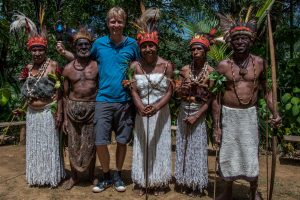 river – the Luhaka tribe is going to perform their ‘Sing Sing’. They paint themselves with natural colours. The orange colour comes from a teardrop-shaped green fruit with red hair sticking out named ‘Guhi’. Inside it has white seeds. When pressed into the palm the white seeds are crushed into a thick orange juice that can be used as natural paint. The dance that is performed is the same dance as the Luhaka tribe performs at the Goroka Show my super nice local guide named Bax tells me. Bax and his family have themselves dug out the terraces and built the houses in this village and cultivated the grounds. The Dancers are wearing their “Bilas” – traditional costumes. An important part of their “Bilas” are feathers from the strange birds of PNG – including the national bird of paradise. I have read that the government is trying to limit the use of these bird feathers since it increases demand for hunting the birds. But Caspar just explains that the people living in the jungle just catch the birds regardless, eat their meat and sell their feathers on the market.
river – the Luhaka tribe is going to perform their ‘Sing Sing’. They paint themselves with natural colours. The orange colour comes from a teardrop-shaped green fruit with red hair sticking out named ‘Guhi’. Inside it has white seeds. When pressed into the palm the white seeds are crushed into a thick orange juice that can be used as natural paint. The dance that is performed is the same dance as the Luhaka tribe performs at the Goroka Show my super nice local guide named Bax tells me. Bax and his family have themselves dug out the terraces and built the houses in this village and cultivated the grounds. The Dancers are wearing their “Bilas” – traditional costumes. An important part of their “Bilas” are feathers from the strange birds of PNG – including the national bird of paradise. I have read that the government is trying to limit the use of these bird feathers since it increases demand for hunting the birds. But Caspar just explains that the people living in the jungle just catch the birds regardless, eat their meat and sell their feathers on the market.
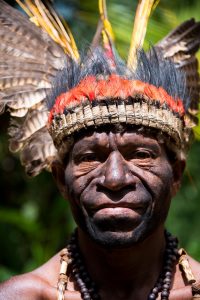 After songs and dances speeches are held. I give a little speech (which Bax translates) about hoping to advertise these ceremonies for other people and about how I would like to one day return here with my kids.
After songs and dances speeches are held. I give a little speech (which Bax translates) about hoping to advertise these ceremonies for other people and about how I would like to one day return here with my kids.
After the ceremony we drink ”Kambe” and tell stories. For the second time (I also told it the day before but Caspar asks me to tell it again) I tell my Libya story. I then tell them about Mona Lisa and how he cut of his own ear (only caspar heard this story before). I then tell them that people in Denmark are rich and can afford to travel but that they are not necessarily happy. My new friends have a hard time understanding how you can be rich but not happy.
Pondo has bought half a liter of “Kambe” in a used coca cola plastic bottle. It is a clear liquid looking like water. It is brewed mainly from bananas but also other fruits are mixed in Bax tells. They call it “homebrewed Beer” but it tastes like more like palm wine. It is quite strong so we mix it with cola.
“We have many algave plants here” Bax tells me. “Could you send me the recipe of Tequila so I can 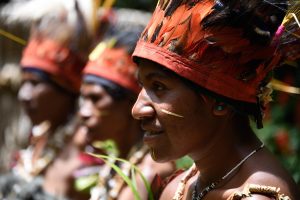 get rich please” he says knowing that algave is the most important ingredient in Tequila. “It is not fair that it is only the Mexicans who knows the formula”. I tell them that back in Denmark we drink Tequila shots with salt and lime and that the lime fruit is sometimes picked up with the teeth from a lady’s cleavage. They think this information is very interesting and I can almost see how their minds are drifting.
get rich please” he says knowing that algave is the most important ingredient in Tequila. “It is not fair that it is only the Mexicans who knows the formula”. I tell them that back in Denmark we drink Tequila shots with salt and lime and that the lime fruit is sometimes picked up with the teeth from a lady’s cleavage. They think this information is very interesting and I can almost see how their minds are drifting.
“The other tourists” just come to see the show and leave again” Pondo says. Under the heavy and vicious mud-man-mask beats a warm and curious heart. “You take your time to sit down and talk to us and listen to us and tell us stories. I would wish all tourists would be like you” he affectionately says. I don’t know if it is the palm wine kicking in but he is getting a little emotional. It is very important to Pondo that I promise to do all that I can to someday return here with my kids and stay with him in his hut in the Asaro village. He says that he will never forget me. The mud-man says he will always be my friend.
Many myths exist about Papua New Guinea and many adventurers rave about the country. Before coming I was a little worried if it could live up to my high expectations. But “Expect the unexpected” is a PNG saying that pretty accurately sums up my excellent experiences in the country. I saw the birds of paradise, met the ever-friendly highland people, saw their spectacular ceremonies and even made friends with some of them. A fantastic country and a very serious challenger to Vanuatu as being the most adventurous country in the Pacific region.

